Introduction
When it comes to optimizing your car audio system, tuning the subwoofer box is a game changer. The right frequency can elevate your listening experience from mediocre to mind-blowing. But with so much information out there, how do you navigate the world of ported enclosures?
Whether you're a seasoned audiophile or just starting your journey into bass-heavy music, understanding the best tuning frequency for a ported box is essential. From calculating enclosure dimensions to choosing the perfect port size, every detail plays a crucial role in achieving that deep and powerful sound you crave. Get ready to dive into the best tuning frequency for ported box and discover what truly makes your subwoofer sing!
How To Calculate Ported Enclosure?
Calculating a ported enclosure requires some basic measurements and formulas. Start by determining the desired internal volume of the box. This is usually based on the specifications provided by your subwoofer manufacturer.
Next, you need to choose your tuning frequency. This can significantly influence performance, typically falling between 25 Hz and 35 Hz for most applications.
Once you've established these numbers, use an online calculator or software designed for audio enclosure design to find the optimal dimensions for your box and ports. You’ll want to input both the volume and tuning frequency into these tools.
Don’t forget about port area as well; it plays a crucial role in airflow within the enclosure. A good rule of thumb is that larger ports reduce air turbulence but require more space compared to smaller ones.
Measure twice, cut once—accuracy is key!
What Is The Best Frequency For Tune Subwoofer Box?
Choosing the best tuning frequency for your subwoofer box is crucial for optimal performance. Generally, a tuning frequency between 30 Hz and 40 Hz works well for most applications. This range allows you to achieve a solid balance between deep bass response and overall sound quality.
If you're targeting low-frequency genres like hip-hop or EDM, leaning toward the lower end of that spectrum can enhance those thumping beats. A higher tune may be preferable if you enjoy rock or pop music, where punchy mid-bass frequencies are more pronounced.
It’s important to note that every setup is unique. Factors such as speaker specifications, room acoustics, and personal listening preferences play significant roles in determining the ideal frequency. Experimenting with different settings can lead to discovering what sounds best for your specific needs and environment.
What Is The Best Port size For Speaker Enclosure?
Choosing the right port size for a speaker enclosure is crucial for optimal performance. The ideal diameter often depends on various factors, including the type of subwoofer and the desired sound characteristics.
A larger port can enhance airflow, reducing turbulence and allowing for higher volumes without distortion. However, if it's too big, it may lead to a loss in control over lower frequencies. This delicate balance is essential.
For most applications, a diameter between 3 to 6 inches works well. It’s important to consider the length of the port as well; longer ports tend to reduce tuning frequency but require careful calculations to avoid unwanted resonances.
Experimentation plays a significant role here. Listening tests can help determine what feels right for your setup. It's about finding that sweet spot where clarity meets power.
Why Turbulence Created?
Turbulence in a ported subwoofer enclosure occurs when the airflow through the ports becomes chaotic. This happens primarily at high volumes, where rapid changes in air pressure create disturbances.
When sound waves travel through the port, they can collide with each other and cause irregular flow patterns. These disruptions lead to unwanted noise and distortion that can muddy your sound quality.
The design of the port plays a significant role here. A poorly sized or shaped port is more prone to turbulence than one optimized for smooth airflow.
Additionally, sharp bends or elbows in the port can exacerbate this issue. The smoother and straighter the path for air to flow, the less likely turbulence will occur.
Minimizing turbulence ensures cleaner bass response and increases overall efficiency in your audio system. It’s all about maintaining a balanced environment within that enclosure space.
Characteristics Of Small Ports
Small ports play a critical role in the performance of ported subwoofer enclosures. They are designed to enhance the responsiveness of the system, particularly at higher frequencies.
One notable characteristic is their ability to reduce unwanted air turbulence. This leads to cleaner sound reproduction with less distortion. When properly sized, small ports can provide quick airflow, allowing for efficient movement of sound waves.
However, they do have limitations. A smaller port may restrict low-end output and limit overall power handling. It’s essential to balance size with the desired acoustic goals.
Additionally, small ports tend to create a tighter bass response. For listeners who prefer punchy beats over deep rumbles, this feature can make all the difference in creating an engaging audio experience.
Understanding these traits helps enthusiasts tailor their setups effectively for specific listening preferences.
Problem With Big Ports
Big ports might seem like a great idea for boosting airflow in your subwoofer enclosure. However, they come with their own set of problems.
One major issue is the increase in turbulence. When air moves too quickly through larger openings, it can create chaotic flow patterns that disrupt sound quality. This distortion can muddy the bass response and lead to an overall less enjoyable listening experience.
Additionally, big ports may compromise tuning accuracy. If not calculated correctly, oversized ports can push the frequency response outside optimal ranges, resulting in weaker performance at critical frequencies.
Moreover, bigger isn't always better when it comes to installation space. Large ports require more room and careful placement within the box design to avoid interference with other components or even causing rattling noises during operation.
Balancing size with function is vital for achieving clear and powerful sound from your audio system.
Is Large Port Good For SPL?
Large ports can indeed be beneficial for achieving high Sound Pressure Levels (SPL). They allow more air to move in and out of the enclosure, which is essential when pushing subwoofers to their limits.
However, size isn't everything. A port that's too large might introduce unwanted turbulence. This turbulence can disrupt airflow and negatively impact sound quality. You want that thumping bass without distortion.
Moreover, the tuning frequency plays a crucial role in how effective a larger port will be. If tuned correctly, it can enhance performance significantly at specific frequencies.
Keep in mind that while large ports facilitate higher output levels, they may sacrifice some low-end response compared to smaller ones. Finding the right balance is key for optimal SPL performance without compromising sound clarity or depth.
Sealed Subwoofer Enclosure
A sealed subwoofer enclosure, often referred to as a "sealed box," is designed for precise sound reproduction. It creates an airtight environment that allows the subwoofer to produce tight bass response.
One of its main advantages is accuracy. These enclosures minimize distortion and deliver deep, controlled lows. This makes them ideal for music genres where clarity and detail are crucial.
Installation can be more straightforward than other types, as they don’t require complex tuning or porting arrangements. They simply need the right volume and internal dimensions specified by the manufacturer.
However, while sealed boxes excel in sound quality, they might lack the raw output found in ported designs. For those who prioritize audio fidelity over sheer loudness, a sealed enclosure can be a perfect choice.
How Does Enclosure Size Affect Tuning Frequency?
The size of a subwoofer enclosure plays a crucial role in determining its tuning frequency. A larger enclosure generally results in a lower tuning frequency, which can enhance deep bass response. This is particularly beneficial for genres that rely on low-end frequencies.
Conversely, smaller enclosures tend to boost higher frequencies. While this can produce tighter sound and quicker response times, it may sacrifice some depth in bass performance. The relationship between volume and tuning is essential; as the internal air space increases or decreases, so does the resonance created inside.
Additionally, different shapes also influence how sound waves interact within the box. Irregularities or variations in design can lead to unexpected changes in acoustic characteristics too. Therefore, careful consideration must be given when designing an enclosure to achieve optimal performance tailored to specific listening preferences.
Conclusion
Choosing the right tuning frequency for a ported subwoofer box is crucial in achieving optimal sound quality. The ideal frequency depends on various factors such as the speaker’s specifications, enclosure size, and desired output characteristics.
Calculating the correct parameters can be complex but understanding how to do it empowers you to tailor your audio experience. A well-tuned enclosure enhances bass response and clarity while minimizing distortion.
Also Visit Them:
Roccat Keyboard Keys Not Working


